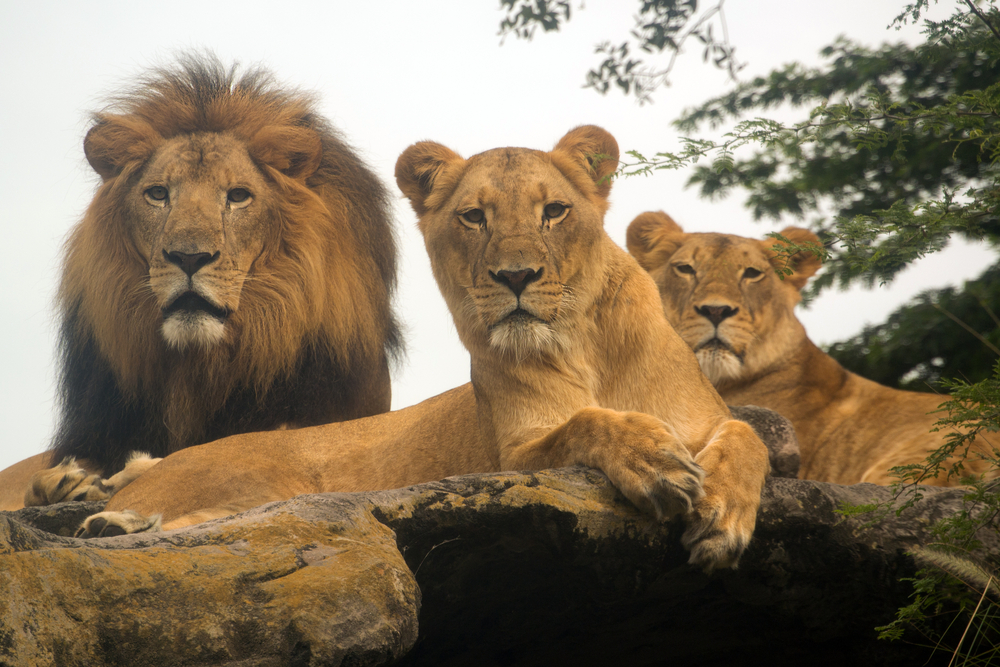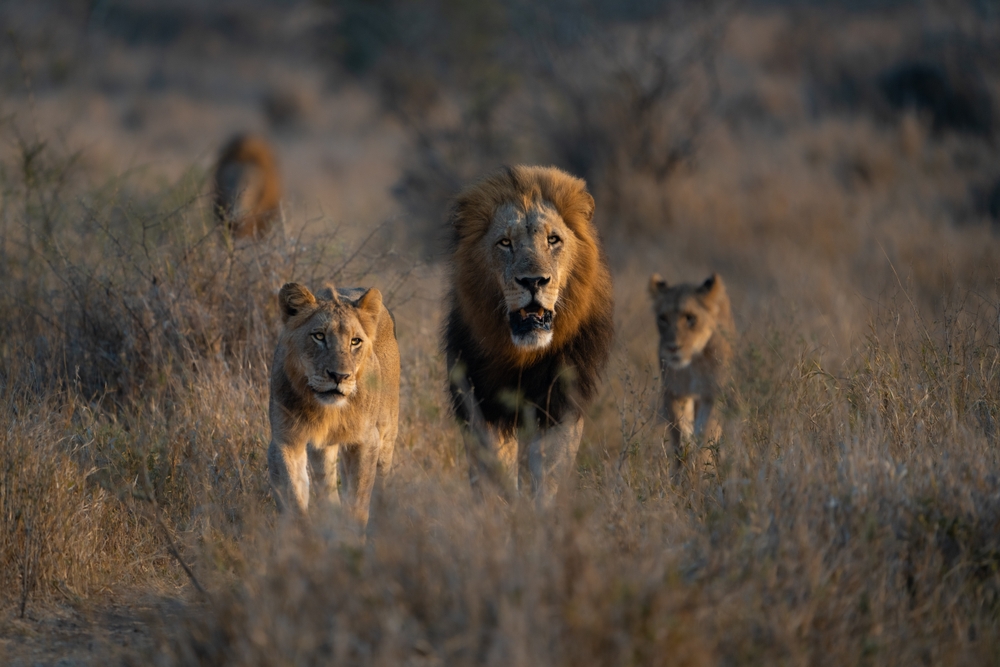
Lions, or the "Kings of the Jungle," as they're often referred to, are known for their complex social structures and territorial behaviors. They are the only big cats that live in groups called prides. All other big cats live in solitary except for mothers and cubs. A pride may comprise 2 to 40 lions – including a dozen females, 3 or 4 males, and their young. All lionesses in a pride are related, and female cubs stay with the group as they age.
Research suggests that the evolution of lions into social animals is intricately linked to the concept of territory. Lions live in pride not only to hunt or sustain their communal lifestyle but also to maintain control over their territory and its essential resources.
Territory plays a critical role in lions' survival and quality of life. A good territory will provide the pride accessibility to everything they need, mainly food, water, and shelter. Food and water go hand in hand – lions settle near water sources because, like them, their prey will seek out water.
Nursery groups (Crèches) within the territory also help protect small cubs from intruders. Lion cubs in Crèche are way more likely to survive than those raised by singleton moms.

Lions are highly social animals that form pride, which consists of related females, their cubs, and a coalition of male lions. These prides exhibit intricate social structures, and their territories are at the heart of their existence. Territories serve as food, water, and shelter sources, making them a key aspect of lion life. In many ways, territorial behaviors define the lion's way of life.
The marking and defense of these territories exemplify territorial behaviors. Lions use scent marking as a defense mechanism to delineate their territory's boundaries. They do this through:
This establishes ownership and acts as a communication method with neighboring pride.
It is a standard lion behavior to fight for dominance in the pride. However, maintaining dominance is an ongoing challenge, as younger, stronger males are always ready to challenge the incumbent leaders. This partly explains why dominant fathers kick out their male cubs when they come of age – usually around 3 years.
The young male lions, usually accompanied by their brother(s) or cousin(s), must make it independently. The sub-adults track other prides, scouting for weakness – injury or old – in the dominant males and take on any opportunity that arises.
Successful takeovers may result in the new male forming alliances with his fellow conquerors or, in some instances, eliminating the cubs of the former leader to establish his bloodline within the pride. Lion dominance comes with privileges, including:
A lone male without a brother or cousin often teams up with another singleton. But if he does not, he'll live an isolated life. And while a lone hunter gets the proverbial lion's share, it will likely not survive alone in the wild.
Roaring is one of the most iconic aspects of lion behavior. Lions use roars to:
Territorial disputes are an inherent part of lion life. When rival pride or nomadic male lions encroach on another's territory, rituals of aggression and intimidation unfold. These pride interactions typically involve intense vocalizations, posturing, and occasional physical confrontations. The outcome of such disputes can lead to shifts in territory boundaries or even pride takeovers.
Ritualized aggression helps minimize physical harm while still determining the victor. It is fascinating to observe how lions engage in these confrontations with calculated aggression, often retreating and re-engaging rather than fighting to the death.
The lion's mane is not merely a symbol of regal appearance; it also plays a crucial role in lion dominance challenges and their social hierarchy. It:

Territorial behaviors have a profound impact on various aspects of lion life. Mating dynamics are closely tied to territory. Male lions use their dominant status and territorial ownership to secure mates and ensure the survival of their bloodline. Lionesses, in turn, choose mates based on their territory's resources, with abundant territories being more attractive.
Hunting strategies are also influenced by territories. Lions rely on their territories' prey availability and strategically hunt within their boundaries. A well-defined territory ensures a stable food source for the pride.
Territorial dynamics extend to interactions among pride members and neighboring pride. Social hierarchies are maintained through the territorial system, reducing intra-pride conflicts. Additionally, pride cohesion is bolstered by the shared territorial defense against external threats.
The lion's survival is closely linked to preserving its natural habitat. Human activities such as deforestation, urbanization, and poaching are encroaching on lion territories, disrupting their natural behaviors. Habitat loss threatens their access to prey, water, and shelter, making it essential to prioritize conservation efforts.
Preserving natural habitats secures the future of lions and maintains the intricate behaviors and territorial systems that make these animals so fascinating. It is our responsibility to ensure that the King of the Jungle continues to reign, undisturbed in their rightful domain. At Lions Tigers & Bears, we advocate for the preservation of natural habitats. We also rescue sick, abused, or exploited lions and provide them with safe and nurturing environments.
Our goal is to ensure the well-being of all animal species in the sanctuary. We provide spacious enclosures allowing residents to roam, run, and climb freely without interspecies conflict. These enclosures are carefully crafted to mimic the diverse elements found in the wild. From incorporating natural features like grass, trees, rocks and water sources to enrichment activities like puzzle feeders, toys, climbing platforms and hidden food items, our design philosophy ensures animals experience an environment that aligns with their instincts and provides a sense of familiarity.
Our habitat design also incorporates safety features such as lockable gates, escape-proof enclosures, and escape routes for emergencies, complemented by surveillance cameras for continuous monitoring. We use strong, high-quality fencing materials to create multiple layers of fencing for protection and include an electric fence for additional safety. Most importantly, we have an on-site veterinary clinic to provide regular health check-ups and medical care and include quarantine areas for new arrivals to prevent the spread of diseases.
LTB's commitment to continuous assessment ensures that habitats evolve to meet changing animal requirements as they age and adapt. Our overarching goal is to provide a sanctuary that prioritizes the animals' well-being, offering a safe, stimulating, and nurturing space for them to thrive.

Ph: 619.659.8078
Fx: 619.659.8841
[email protected]
24402 Martin Way, Alpine, CA 91901